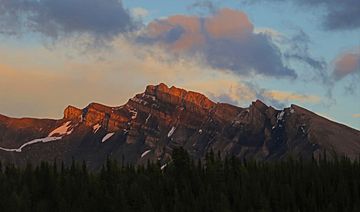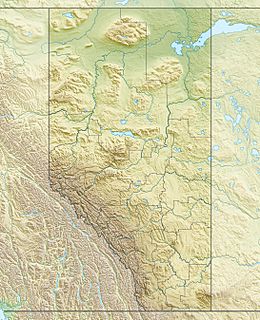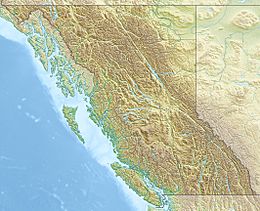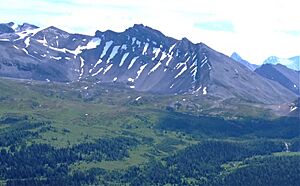Wonder Peak facts for kids
Quick facts for kids Wonder Peak |
|
|---|---|

Wonder Peak at sunset
|
|
| Highest point | |
| Elevation | 2,852 m (9,357 ft) |
| Prominence | 165 m (541 ft) |
| Geography | |
| Location | Alberta British Columbia |
| Parent range | Canadian Rockies |
| Topo map | NTS 82J/13 |
| Climbing | |
| First ascent | 1913 Conrad Kain, Boundary Commission |
Wonder Peak is a tall mountain found in the beautiful Canadian Rockies. It sits right on the border between two Canadian provinces: Alberta and British Columbia. This means if you stand on its top, you're in two places at once!
The mountain is also part of the Continental Divide. This is like a giant line across North America where rivers on one side flow to the Pacific Ocean, and rivers on the other side flow to the Atlantic or Arctic oceans. Wonder Peak also touches the edges of two big parks: Banff National Park and Mount Assiniboine Provincial Park. It was given its name in 1913 by two explorers, Arthur O. Wheeler and Conrad Kain.
How Was Wonder Peak Formed?
Wonder Peak is made up of different kinds of sedimentary rock. This rock formed over millions of years, from the Precambrian time all the way to the Jurassic period. Imagine tiny bits of sand, mud, and shells settling at the bottom of ancient, shallow seas. Over time, these layers got squished and hardened into rock.
Later, a huge event called the Laramide orogeny happened. This was when massive forces deep inside the Earth pushed and folded the land. It caused these old sedimentary rocks to be lifted up and even pushed over younger rocks, creating the tall mountains we see today, like Wonder Peak!
What's the Weather Like on Wonder Peak?
Wonder Peak has a subarctic climate. This means it has very cold winters with lots of snow. Summers are usually mild, but not super warm.
Temperatures can drop really low, sometimes even below -20°C (which is -4°F). When the wind blows, it can feel even colder, making it feel like -30°C (-22°F) or less! So, if you ever visit, make sure to bundle up!




